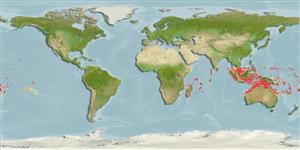ກຸ່ມປາກະດູກອ່ອນ (ເຊັ່ນ: ປາສະຫລາມ, ປາຜາໄລ) (sharks and rays) >
Myliobatiformes (Stingrays) >
Dasyatidae (Stingrays) > Urogymninae
Etymology: Pateobatis: Combination of Latin 'pateo' for 'lie open, be exposed' and 'batis' for skate, ray or flatfish; referring to the eclectic nature of members of this group..
More on authors: Jordan & Seale.
Environment: milieu / climate zone / depth range / distribution range
ນິເວດວິທະຍາ
ສັດທະເລ ກ່ຽວກັນຫີນ; ລະດັບຄວາມເລິກ 0 - 200 m (Ref. 86942). Tropical; 9°N - 26°S
Indo-West Pacific: widespread, from South Africa to the central Pacific Islands, north to Japan (Okinawa). Frequently confused with Himantura jenkinsii (Ref. 9840).
Length at first maturity / ຂະໜາດ / ນ້ຳໜັກ / Age
Maturity: Lm 115.4, range 120 - ? cm
Max length : 183 cm TL ຕົວຜູ້/ບໍ່ມີເພດ; (Ref. 40637); ນ້ຳໜັກສູງສຸດທີ່ເຄຍຈັດພີມມາ: 18.5 kg (Ref. 40637)
Uniformly tan to brownish pink dorsally. Inhabits lagoon and seaward sand flats from the intertidal to at least 200 m. Occurs in large aggregations (Ref. 37816).
Occurs in aggregations over soft bottoms of the inner continental shelf, often near coral reefs (Ref. 9840). Ovoviviparous (Ref. 50449). Size at birth at about 55 cm WD (Ref. 6871). Feeds on fishes, crustaceans and molluscs (Ref. 89972). Common catch of the demersal tangle net, bottom trawl and, to a lesser extend, longline fisheries. Utilized for its meat, skin (high value) and cartilage (Ref.58048). By-catch of prawn trawlers (Ref. 6871).
Life cycle and mating behavior
ການຈະເລີນເຕັມໄວ | ການສືບພັນ | ການວາງໄຂ່ | ໄຂ່ | ຄວາມດົກຂອງໄຂ່ປາ | ຕົວອ່ອນ
Exhibit ovoviparity (aplacental viviparity), with embryos feeding initially on yolk, then receiving additional nourishment from the mother by indirect absorption of uterine fluid enriched with mucus, fat or protein through specialised structures (Ref. 50449). Distinct pairing with embrace (Ref. 205). Size at birth ~ 55 cm WD (Ref.58048).
Mould, B., 1994. A world list of rays. The scientific nomenclature and distribution of the recent Batoidea (Batoidea, Elasmobranchii, Chondrichthyes). University of Nottingham, [UK]. 82 p. (Ref. 8630)
IUCN Red List Status (Ref. 130435)
Threat to humans
Venomous
Human uses
ການປະມົງ: ທີ່ເປັນການຄ້າໜ້ອຍ
ຂໍ້ມູນຕື່ມອີກ
ເອກະສານອ້າງອີງການລ້ຽງສັດນ້ຳຂໍ້ມູນການລ້ຽງສັດນ້ຳສາຍພັນກຳມະພັນElectrophoresesການຖ່າຍທອດທາງກຳມະພັນຈາກພໍ່ແມ່ຫາລູກພະຍາດການປຸງແຕ່ງNutrientsMass conversion
ເຄື່ອງມື
Special reports
Download XML
ແຫຼ່ງອີນເຕີເນັດ
Estimates based on models
Preferred temperature (Ref.
123201): 23.7 - 28.2, mean 26.7 °C (based on 471 cells).
Phylogenetic diversity index (Ref.
82804): PD
50 = 0.5312 [Uniqueness, from 0.5 = low to 2.0 = high].
Bayesian length-weight: a=0.00832 (0.00366 - 0.01891), b=3.10 (2.90 - 3.30), in cm total length, based on LWR estimates for this (Sub)family-body shape (Ref.
93245).
ຊັ້ນເຂດຮ້ອນ (Ref.
69278): 3.7 ±0.57 se; based on food items.
ຄວາມຢືດຢຸ່ນ (Ref.
120179): ຕຳ່, ປະຊາກອນຕຳ່ສຸດທີ່ໃຊ້ເວລາສອງເທົ່າ 4.5 - 14 ປີ (Assuming fecundity<100).
Fishing Vulnerability (Ref.
59153): Very high vulnerability (90 of 100).
Nutrients (Ref.
124155): Calcium = 4.72 [0.53, 68.64] mg/100g; Iron = 0.359 [0.028, 3.857] mg/100g; Protein = 21.3 [18.7, 23.9] %; Omega3 = 0.0812 [, ] g/100g; Selenium = 45.3 [8.5, 225.5] μg/100g; VitaminA = 19.5 [1.6, 202.1] μg/100g; Zinc = 0.609 [0.036, 7.165] mg/100g (wet weight);
